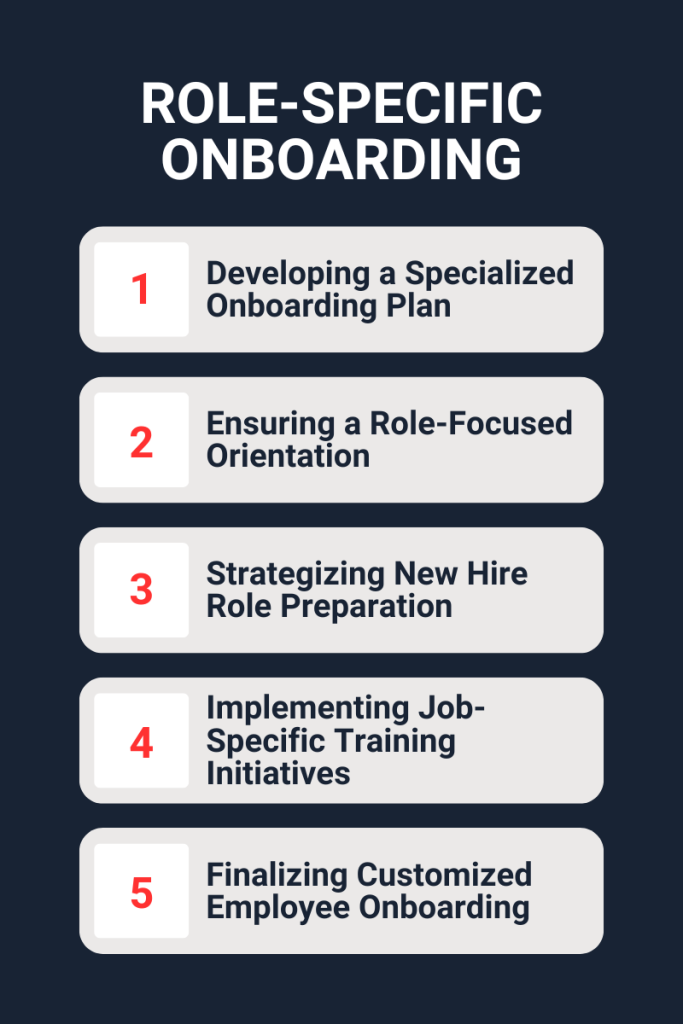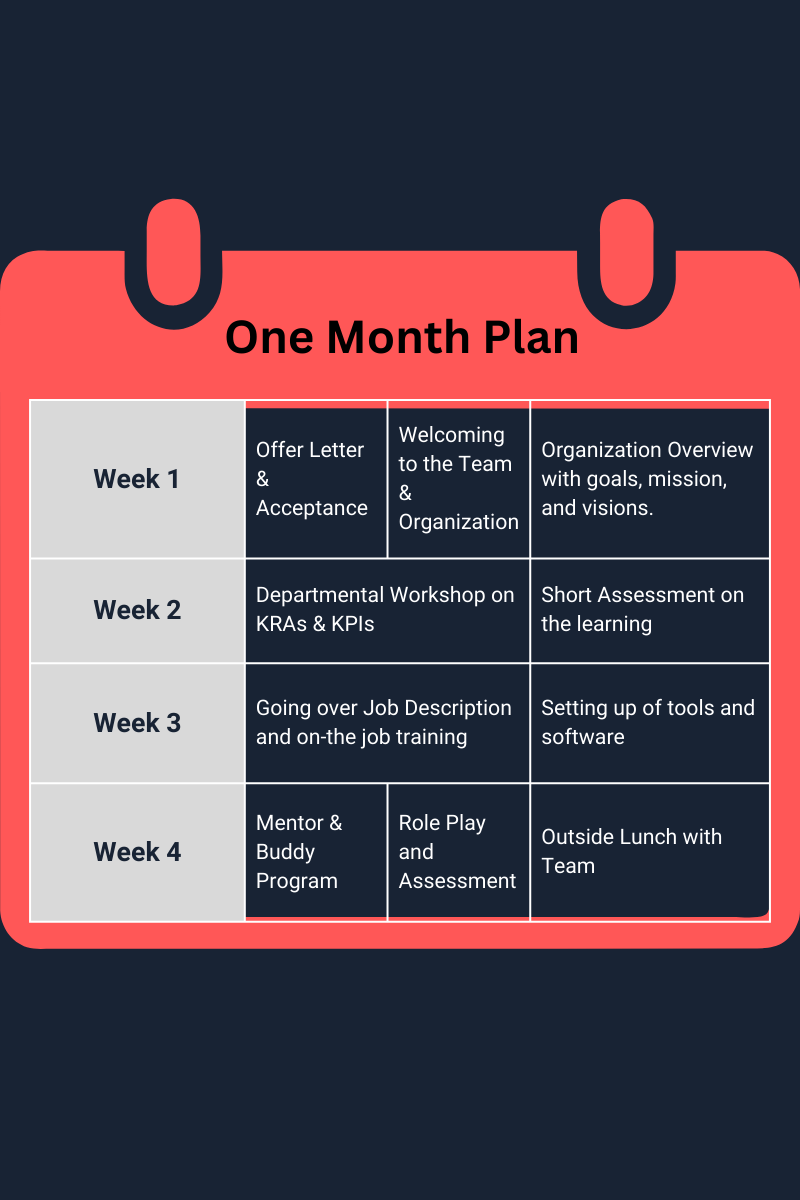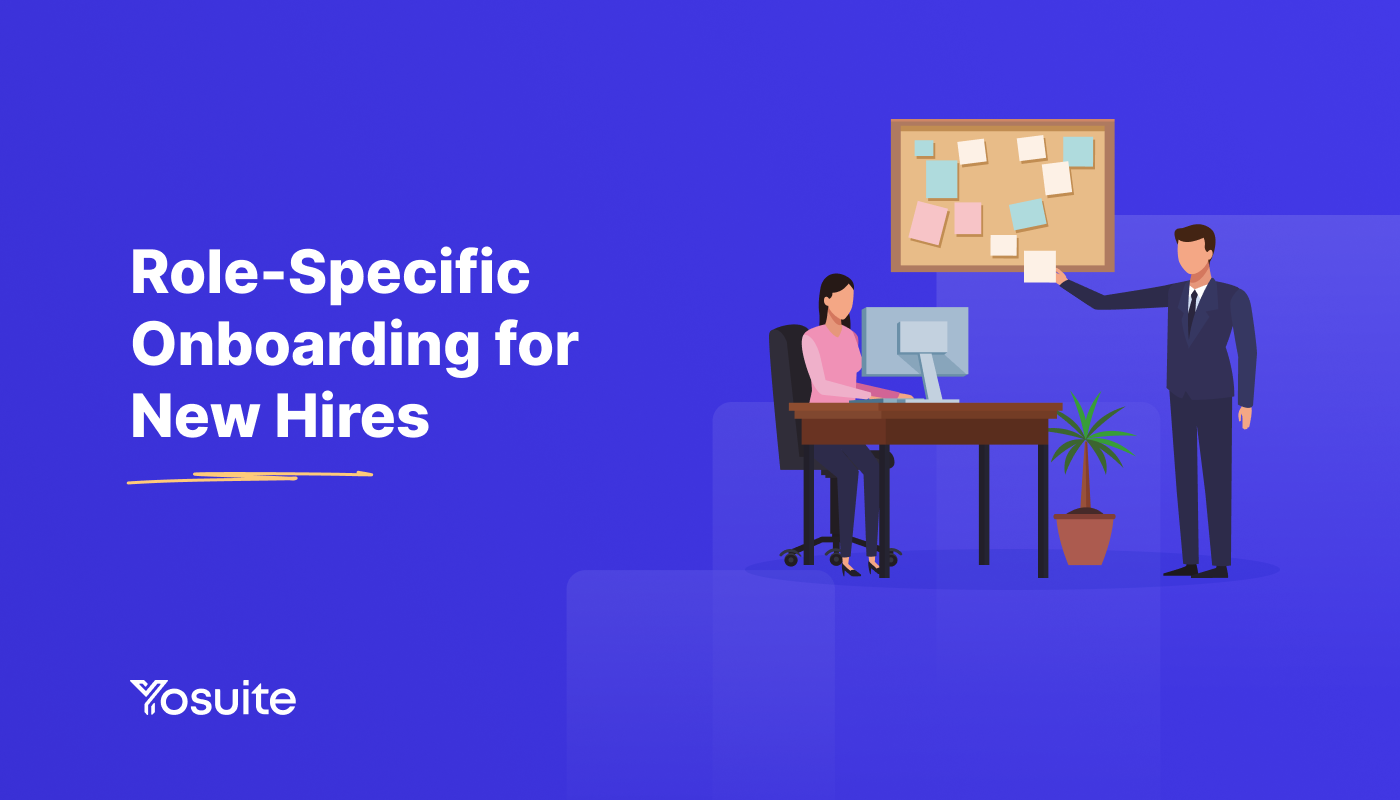With multiple roles and positions to manage, role-specific onboarding is increasingly becoming paramount to onboarding the right candidates.
While general onboarding offers a broader overview, role-specific onboarding provides a more tailored experience designed to equip new hires with the skills, knowledge, and resources unique to their position.
In this blog post, we’ll explore what role-specific onboarding is, how it differs from traditional onboarding, and why it matters in creating an engaged, effective workforce.
Table of Contents
What is Role-Specific Onboarding?
Role-specific onboarding process presents a focused approach with emphasis on the new hire’s specific job responsibilities. It is more than general company introductions and policies, directing new hires into the skills, tools, and workflows essential to perform their role optimally.
The goal is to enable the new hire to quickly become competent and confident in performing the tasks related to their position while aligning with the company culture and expectations.
Remember, around 70% of new hires decide whether a job is the right fit within the first month, according to a report by BambooHR.
Unlike traditional onboarding, where all employees go through a standardized process, role-specific onboarding customizes the experience to meet the individual needs of each role.
Position-Specific Onboarding vs Generic Onboarding
So, let’s first compare the two types of onboarding.
Generic onboarding typically covers broad organizational topics like company history, culture, HR policies, and general expectations for employees. While this offers valuable context, it doesn’t delve into the day-to-day tasks and responsibilities a new hire will face in their specific role.
An example would be going over the company mission and vision with all the new hires from different departments during an orientation session.
On the other hand, position-specific or role-specific onboarding complements the broader company overview by providing tailored training and information. It addresses the unique challenges, tools, and workflows the new hire will encounter while executing his tasks.
For example, an IT specialist would need technical training on the systems they’ll manage, while a salesperson would focus on product knowledge and customer interaction strategies. The information and knowledge shared will cover departmental codes of practices, tools, and methods of doing work, and other department-specific policies.
The following table summarizes the key differences between the two onboarding types:
| Key Difference Area | General Onboarding | Role-Specific Onboarding |
|---|---|---|
| Focus | Company-wide integration | Job-specific tasks |
| In-depth | Often lasts only a few days | May extend over several weeks |
| Training | Provides broad, general company information; off-the-job | Offers deeper, more detailed on-the-job training |
| Responsible Person | Usually HR | The Departmental Lead or Manager |
Creating an Effective Role-Based Onboarding Process

During a survey in 2022 by Leena AI, surveyants were asked for their top 5 onboarding challenges. 40% of HR professionals mentioned the disconnect between hiring and onboarding processes.
To ensure your role-specific onboarding is impactful, the process must be thoughtfully designed and well-executed. Here are key practices to guide the creation of an effective role-based onboarding program. These will help in crafting a robust role-specific onboarding experience.
Step 1: Developing a Specialized Onboarding Plan
The first step in role-specific onboarding is developing a detailed, specialized plan that outlines everything the new hire needs to know. The plan should be developed during the pre-onboarding stage or before that.
The plan should include your key objectives, timelines, resources, and mentors’ list. It should answer:
➡️ What are the core skills and knowledge the employee needs to succeed in their role?
➡️ When should they master each component of their job?
➡️ What tools, documents, or training materials are necessary?
➡️ Who can guide the new hires through the nuances of the position?
➡️ When will the onboarding process start and end?
➡️ What activities will be included that relate to the particular role?
➡️ How long should each step or activity be?
The onboarding plan should be flexible enough to account for individual learning speeds but structured to ensure a smooth transfer of training into the role.
Step 2: Ensuring a Role-Focused Orientation
In addition to the general company orientation, new hires should receive a role-focused orientation session. This session introduces them to their specific department, key team members, role expectations, and goals.
Here, you should introduce the Job responsibilities of the employee with a detailed overview of day-to-day tasks. You should also help them understand how their new team operates and the department’s mission within the broader organization.
Through a tailored onboarding experience, Performance expectations should be set, and these should be clearly communicated with metrics and departmental KPIs.
This orientation should make the new hire feel comfortable in their role and familiar with the environment in which they’ll be working.
Step 3: Strategizing New Hire Role Preparation
Another step you must take is to prepare your new hires for on-the-job success by introducing them to the tools, software, and systems they will be using. Make sure the new hire has access to all the resources they need from day one.
For this, you can provide system logins and tool access, offer hands-on training with key tools relevant to the role, and arrange team shadowing. In other words, let them observe peers in similar roles to see the day-to-day job execution.
This preparation ensures that new hires feel empowered and confident in dealing with the technical aspects of their new position.
Step 4: Implementing Job-Specific Training Initiatives
Training enhances of role-specific onboarding. Rather than overwhelming a new hire with broad-based training, focus on job-specific training initiatives that build the core competencies they need.
You can utilize strategies like organizing Interactive workshops that are aligned with the new hire’s responsibilities. You can also arrange on-the-job training sessions that allow the new hire to gradually take over tasks while being coached by an experienced team member.
Besides that, you can encourage existing departmental members to enact role-playing or simulation exercises that can be particularly useful in customer-facing roles, sales, or technical problem-solving jobs.

For instance, you can ask customer service employees to enact a skit revolving around how to deal with difficult customers and manage your anger at boiling point. This will definitely help the new hire understand how to interact with customers in tough situations.
Top these off by giving regular feedback during the training phase. There should be pre and post-training evaluation forms for both the trainers and trainees so that proper feedback from both ends exists. That will help refine skills, improve the confidence of new hires and help supervisors identify probable skill or knowledge gaps.
Step 5: Finalizing Customized Employee Onboarding
The last phase of role-specific onboarding should include a wrap-up meeting or evaluation to ensure all necessary training and sharing of resources is complete. This can happen anytime within the probation period (usually 3 to 6 months) of an employee or in a predetermined duration of time.
Ideally, assessments and checks of progress are made in a 30-60-90 day rule. That is, as the name implies, after one, two, or three months of monitoring and training.
The meeting or follow-up should also include feedback on the required document submission.
This strategy provides an opportunity to assess progress and determine how well the new hire has adapted to their role. It also shows whether they’ve mastered core competencies or not.
You should also let the new hires address questions or concerns about their tailored onboarding experience. This will help you and the new hire set future goals to establish performance targets for the coming months.
And remember, finalizing the onboarding process doesn’t mean the learning stops—it simply marks the transition from structured training to ongoing professional development.
Benefits of a Tailored Onboarding Experience
Tailoring the onboarding process to a new hire’s specific role offers numerous advantages, including:
✅ Quicker increase in productivity
By focusing on role-specific tasks, new hires can become productive more quickly. As they learn the ways and functions of their roles from the onset, it becomes easier to adopt the rules of the game and adapt when changes occur. And, you become confident you have recruited the right resource.
✅ Higher retention rates
Employees who feel supported and prepared in their role are more likely to stay with the company long-term. Because the hire feels part of the team, as they learn and adapt, their intent to stay with the organization is stronger than someone receiving the general onboarding process. Thus, also reducing employee turnover rates.
✅ More improved performance
Role-specific onboarding ensures that employees have the right skills and knowledge from the start, leading to better overall performance. If you are dealing with freshers or novice employees, this becomes essential as you need to teach and guide them more.
✅ Greater job satisfaction
Personalized onboarding helps new hires feel valued and engaged. This helps to boost their morale and job satisfaction. Also, there is an increase in their self-efficacy. Anyone feeling valued will participate in and contribute more to a team.
✅ Better communication flow
When new employees understand the rules and feel absorbed in a team, the communication flows well, both upward and downward. Managers can convey their messages better, and the employees can grasp the manager’s directives much more easily. This also helps to define employee and business expectations more smoothly.
✅ Stronger company branding
Employees who understand and grasp their KPIs and Key Result Areas (KRAs) earlier can align those with the company’s vision. This allows them to brand their employer better and creates confidence and trust in the organization.
Limitations of a Targeted Onboarding Program
Though role-specific onboarding has significant benefits, you must note some limitations as well to look into them when planning and implementing the process:
🔴 Time and resource-intensive
Customizing onboarding for each role requires more time, effort, and resources compared to a one-size-fits-all approach. You would need to go into more detail when developing the plan and materials, as well as manage logistics that pertain to the specific role.
🔴 Risk of knowledge gaps
If too much focus is placed on role-specific tasks, new hires may miss out on understanding broader company goals and culture. This issue can create a riff among different functional teams and even the management who always emphasize the overall company goal and vision.
🔴 Potential for inconsistency
Without standardized guidelines, role-specific onboarding may vary in quality across different departments or teams. There are possibilities of unexpected events like malfunctioning of equipment or below-par mentorship that can hinder the proper learning of the new hires.
🔴 Routine and repetition
Often, when the focus and resources are limited, the onboarding process may become repetitive and routine. This can be especially disengaging for job-specific training during onboarding. The new employee orientation may include the same, old materials that were shared in the last five years. This can be a total turn-off for young, emerging hires who are bulging with new ideas and want some fast on-the-job “action”.
However, you as the HR person can tackle and overcome these issues. A well-designed role-specific onboarding process can greatly enhance the new hire experience and contribute to long-term success.
Do’s and Don’ts for Role-based Onboarding
So, now that we have gone over the process, ideal practices, benefits, and challenges of tailored onboarding experience, let’s briefly go over the do’s and don’ts:
| The Do’s | The Don’ts |
| 🟩 Creating a welcoming environment 🟩 Laying out the expectations 🟩 Making it real with examples 🟩 Explaining what the typical day looks like 🟩 Emphasizing the uniqueness of the department 🟩 Giving constant feedback and coaching | 🟥 Assuming that one-size-fits-most 🟥 Not considering the importance of other roles 🟥 Creating plans in isolation 🟥 Expecting new hires to be ready for change in role 🟥 Ignoring general business goals and plans 🟥 Underestimating the importance of diversity |
A summarized role-specific onboarding experience (1 month)
Finally, let’s look at a one-month job-focused onboarding plan for a group of new hires in the marketing department. Please note that, this customized plan includes weekly 2-3 days of onboarding and orientation activities:

🎯 Explore top Onboarding tools to drive your process
Summing Up
Role-specific onboarding is an investment in your new hire’s success, aligning their training with the unique demands of their job. By focusing on job-specific knowledge, skills, and resources, you can accelerate the time it takes for them to contribute meaningfully to your organization.
While there are a few limitations, the benefits of increased productivity, job satisfaction, and employee retention make role-specific onboarding a valuable strategy for any organization.

Leave a Reply